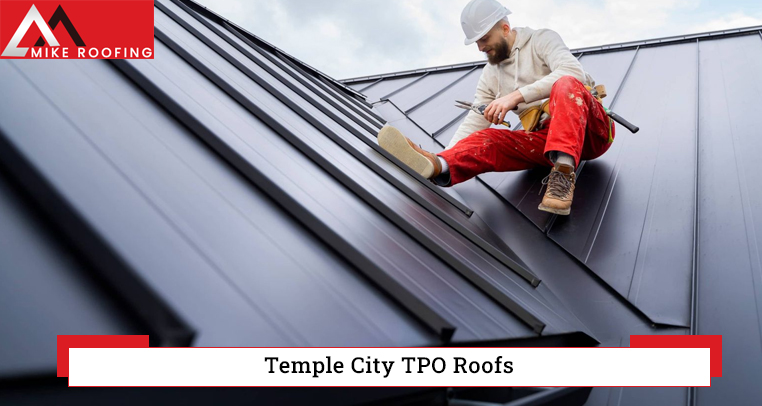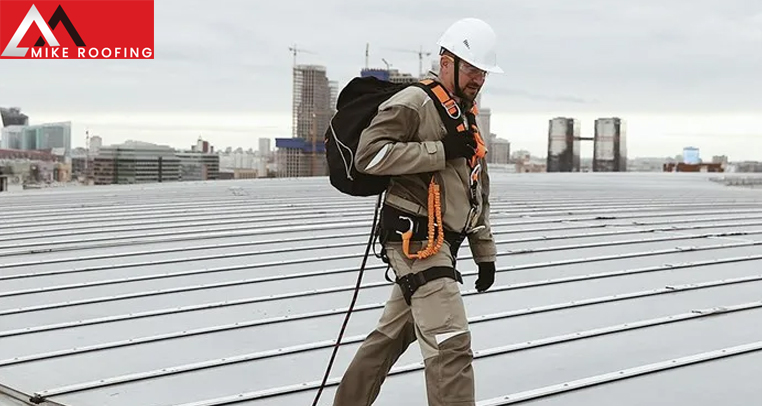Temple City TPO Roofs
TPO roofing is a popular choice for commercial and industrial buildings in Temple City, offering exceptional durability, energy efficiency, and weather resistance. With its sleek appearance and low maintenance requirements, Temple City TPO Roofs is an ideal solution for property owners looking to protect their investment and reduce long-term costs.
At Mike Roofing, we specialize in TPO roof installation, repair, and maintenance. Our experienced team is dedicated to providing top-quality workmanship and exceptional customer service, ensuring your TPO roof performs optimally for years to come.

Benefits of Choosing TPO Roofing
TPO (Thermoplastic Polyolefin) roofing has gained popularity in Temple City due to its numerous benefits. This single-ply membrane is known for its:
Durability
TPO roofs are highly resistant to tears, punctures, and impact damage. The flexible, yet strong material can withstand foot traffic, hail, and other physical stressors, making it an ideal choice for commercial and industrial buildings.
Energy efficiency
The reflective surface of TPO helps reduce cooling costs by reflecting sunlight and heat away from the building. This can lead to significant energy savings, especially during the hot summer months in Temple City.
UV resistance
TPO membranes are designed to withstand harsh UV rays, preventing the material from breaking down or deteriorating over time. This UV resistance contributes to the longevity and durability of TPO roofs.
Low maintenance
TPO roofs require minimal upkeep, saving property owners time and money. The smooth surface of TPO is resistant to dirt and debris accumulation, and any necessary cleaning can be done easily with simple tools and cleaning agents.
TPO vs Other Commercial Roofing
When considering commercial roofing options, it’s essential to understand how TPO compares to other materials. The following table highlights the key differences between TPO and two other popular choices:
| Feature | TPO | EPDM | PVC |
|---|---|---|---|
| Durability | High | High | High |
| Energy Efficiency | High | Low | High |
| UV Resistance | High | High | High |
| Cost | Moderate | Low | High |
| Installation | Easy | Moderate | Moderate |
Is It Time to Replace Your Temple City TPO Roof?
Knowing when to replace your TPO roof is crucial for maintaining the integrity of your building. Some signs that indicate it’s time for a replacement include:
- Age: TPO roofs typically last 15-20 years, depending on maintenance and weather conditions. If your roof is approaching or exceeding this age range, it may be time to consider a replacement to prevent leaks and other issues.
- Visible damage: Cracks, punctures, or tears in the TPO membrane can allow water to penetrate the roof and cause damage to the underlying structure. If you notice any visible damage to your TPO roof, it’s essential to have it assessed by a professional roofing contractor.
- Ponding water: Standing water on the roof can lead to leaks and damage over time. If you notice ponding water on your TPO roof that doesn’t drain properly, it may be a sign of underlying issues that require attention.
- Increased energy bills: A damaged or worn TPO roof may not provide optimal insulation, leading to increased energy consumption and higher utility bills. If you notice a sudden increase in your building’s energy costs, it may be related to the condition of your TPO roof.
TPO Roofing Codes & Compliance
Ensuring your TPO roof meets local building codes and regulations is essential for safety and legal compliance. Some key considerations include:
- Fire ratings: TPO roofs must meet specific fire resistance standards, such as those set by the UL (Underwriters Laboratories) or FM (Factory Mutual), to ensure the safety of the building and its occupants in the event of a fire.
- Wind uplift resistance: TPO installations should be designed to withstand high winds, with proper attachment methods and edge securement to prevent uplift and damage. Local building codes may specify minimum wind uplift resistance requirements based on the area’s weather conditions.
- Energy efficiency: Some areas may require TPO roofs to meet certain energy efficiency standards, such as those set by the ENERGY STAR program or local green building initiatives. These standards help promote energy conservation and reduce the environmental impact of commercial buildings.
- Proper installation: TPO roofs must be installed according to manufacturer guidelines and local codes to ensure optimal performance and longevity. This includes proper substrate preparation, membrane attachment, seam welding, and flashing installation.

TPO Roofing in Different Weather
Temple City experiences a variety of weather conditions throughout the year, and TPO roofs are designed to perform well in various climates:
- Hot weather: TPO’s reflective surface helps reduce heat absorption and cooling costs by reflecting sunlight and heat away from the building. This can lead to significant energy savings and improved indoor comfort during the hot summer months in Temple City.
- Cold weather: TPO remains flexible in low temperatures, resisting cracks and shrinkage that can occur with other roofing materials. This flexibility helps maintain the roof’s integrity and prevents leaks during cold weather.
- Rainy weather: Properly installed TPO roofs provide excellent waterproofing and drainage, ensuring that water is effectively channelled away from the building. The heat-welded seams and secure attachment methods prevent water infiltration, even during heavy rainfall.
- High winds: TPO roofs can be designed to withstand strong winds, preventing uplift and damage. Proper installation techniques, such as using appropriate fasteners and adhering to manufacturer guidelines, help ensure the roof’s stability in high wind conditions.


